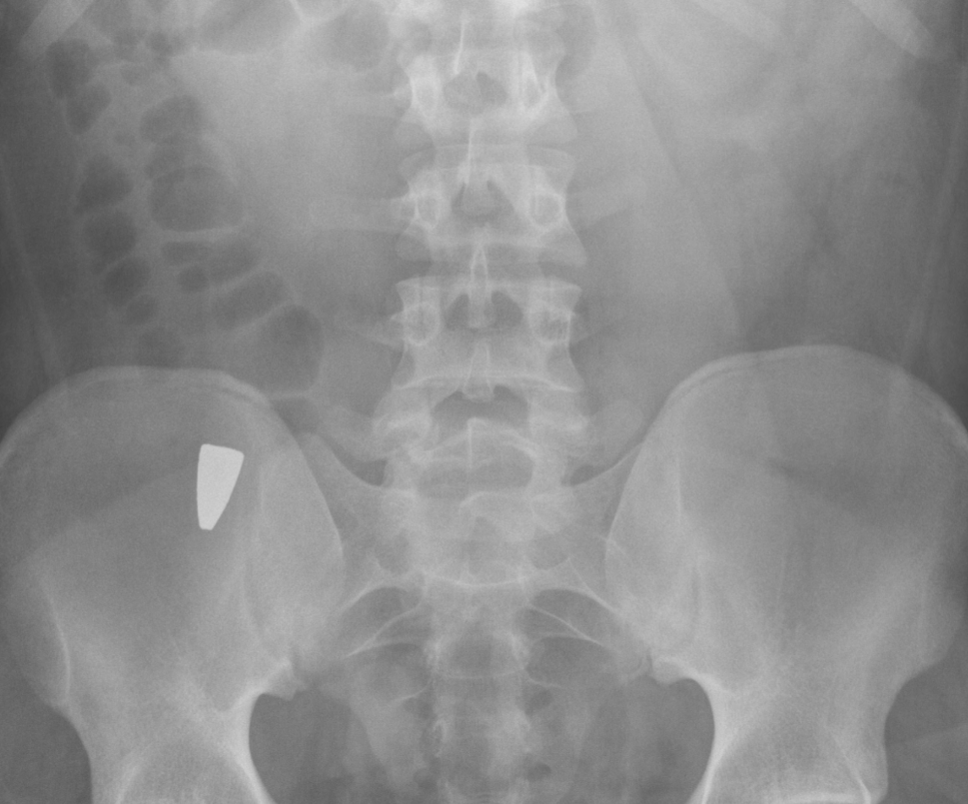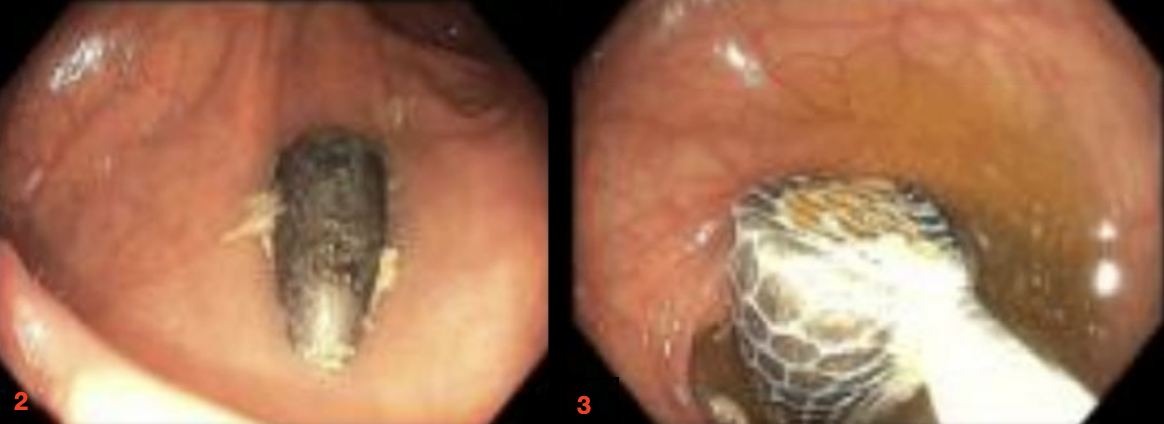Tuesday Poster Session
Category: Colon
P4676 - When Lead Lingers: A Case of Cecal Foreign Body and Concern for Systemic Toxicity
Tuesday, October 28, 2025
10:30 AM - 4:00 PM PDT
Location: Exhibit Hall
.jpg)
Daniel Kalta, DO, MS
Staten Island University Hospital
Staten Island, NY
Presenting Author(s)
Award: ACG Presidential Poster Award
Daniel Kalta, DO, MS1, Rajarajeshwari Ramachandran, MD2, Ethan Babich, 3, Vinaya Gaduputi, MD4
1Staten Island University Hospital, Staten Island, NY; 2Fresno Veterans Affairs Medical Center, Fresno, CA; 3The Frisch School, Paramus, NJ; 4Blanchard Valley Health System, Findlay, OH
Introduction: We are presenting a case of accidental ingestion of a lead fishing weight, resulting in elevated blood lead levels. The patient underwent successful endoscopic removal of the colonic foreign body made of lead.
Case Description/
Methods: An 18-year-old male presented to the hospital after accidental ingestion of a fishing weight made of lead. After ingestion of the foreign body, he was self-administering polyethylene glycol bowel preparation, expecting the foreign body to pass. The patient waited a week, but he did notice the foreign body in his stool, so he decided to seek medical attention. He denied abdominal pain, nausea, vomiting or neurological symptoms. On examination, the abdomen was soft, nontender, without organomegaly or ascites. No focal neurological deficits were noted.
An X-ray of the abdomen showed a teardrop-shaped metallic foreign body over the right hemipelvis (image 1). CT abdomen and pelvis without intravenous contrast was performed and a 2.5x1 cm cylindrical foreign body was seen in the mid to distal jejunum without evidence of bowel obstruction. His blood lead level was elevated at 47 mcg/dL and the local poison control department was contacted. Given the elevated blood lead level, decision was made to perform colonoscopy with endoscopic removal of the foreign body.
During colonoscopy the foreign body was identified in the cecum and removed using Roth Net (images 2&3). Blood lead level was rechecked 8 weeks after the removal of the foreign body and was down trending at 23 mcg/dL. He was advised to follow up with his primary care physician for further monitoring of lead levels.
Discussion: There are rare cases of lead poisoning due to foreign body ingestions requiring endoscopic removal. Our patient presented one week after accidental ingestion of fishing weight made of lead. Despite the absence of clinical signs of lead toxicity, our patient underwent successful endoscopic removal of the cecal foreign body due to the elevated blood lead level.

Figure: X-ray of the abdomen showing a metallic foreign body over the right hemipelvis

Figure: Image 2: Colonoscopy image: metallic foreign body in the cecum
Image 3: Colonoscopy image: during removal of the foreign body using Roth Net
Disclosures:
Daniel Kalta indicated no relevant financial relationships.
Rajarajeshwari Ramachandran indicated no relevant financial relationships.
Ethan Babich indicated no relevant financial relationships.
Vinaya Gaduputi indicated no relevant financial relationships.
Daniel Kalta, DO, MS1, Rajarajeshwari Ramachandran, MD2, Ethan Babich, 3, Vinaya Gaduputi, MD4. P4676 - When Lead Lingers: A Case of Cecal Foreign Body and Concern for Systemic Toxicity, ACG 2025 Annual Scientific Meeting Abstracts. Phoenix, AZ: American College of Gastroenterology.
Daniel Kalta, DO, MS1, Rajarajeshwari Ramachandran, MD2, Ethan Babich, 3, Vinaya Gaduputi, MD4
1Staten Island University Hospital, Staten Island, NY; 2Fresno Veterans Affairs Medical Center, Fresno, CA; 3The Frisch School, Paramus, NJ; 4Blanchard Valley Health System, Findlay, OH
Introduction: We are presenting a case of accidental ingestion of a lead fishing weight, resulting in elevated blood lead levels. The patient underwent successful endoscopic removal of the colonic foreign body made of lead.
Case Description/
Methods: An 18-year-old male presented to the hospital after accidental ingestion of a fishing weight made of lead. After ingestion of the foreign body, he was self-administering polyethylene glycol bowel preparation, expecting the foreign body to pass. The patient waited a week, but he did notice the foreign body in his stool, so he decided to seek medical attention. He denied abdominal pain, nausea, vomiting or neurological symptoms. On examination, the abdomen was soft, nontender, without organomegaly or ascites. No focal neurological deficits were noted.
An X-ray of the abdomen showed a teardrop-shaped metallic foreign body over the right hemipelvis (image 1). CT abdomen and pelvis without intravenous contrast was performed and a 2.5x1 cm cylindrical foreign body was seen in the mid to distal jejunum without evidence of bowel obstruction. His blood lead level was elevated at 47 mcg/dL and the local poison control department was contacted. Given the elevated blood lead level, decision was made to perform colonoscopy with endoscopic removal of the foreign body.
During colonoscopy the foreign body was identified in the cecum and removed using Roth Net (images 2&3). Blood lead level was rechecked 8 weeks after the removal of the foreign body and was down trending at 23 mcg/dL. He was advised to follow up with his primary care physician for further monitoring of lead levels.
Discussion: There are rare cases of lead poisoning due to foreign body ingestions requiring endoscopic removal. Our patient presented one week after accidental ingestion of fishing weight made of lead. Despite the absence of clinical signs of lead toxicity, our patient underwent successful endoscopic removal of the cecal foreign body due to the elevated blood lead level.

Figure: X-ray of the abdomen showing a metallic foreign body over the right hemipelvis

Figure: Image 2: Colonoscopy image: metallic foreign body in the cecum
Image 3: Colonoscopy image: during removal of the foreign body using Roth Net
Disclosures:
Daniel Kalta indicated no relevant financial relationships.
Rajarajeshwari Ramachandran indicated no relevant financial relationships.
Ethan Babich indicated no relevant financial relationships.
Vinaya Gaduputi indicated no relevant financial relationships.
Daniel Kalta, DO, MS1, Rajarajeshwari Ramachandran, MD2, Ethan Babich, 3, Vinaya Gaduputi, MD4. P4676 - When Lead Lingers: A Case of Cecal Foreign Body and Concern for Systemic Toxicity, ACG 2025 Annual Scientific Meeting Abstracts. Phoenix, AZ: American College of Gastroenterology.

